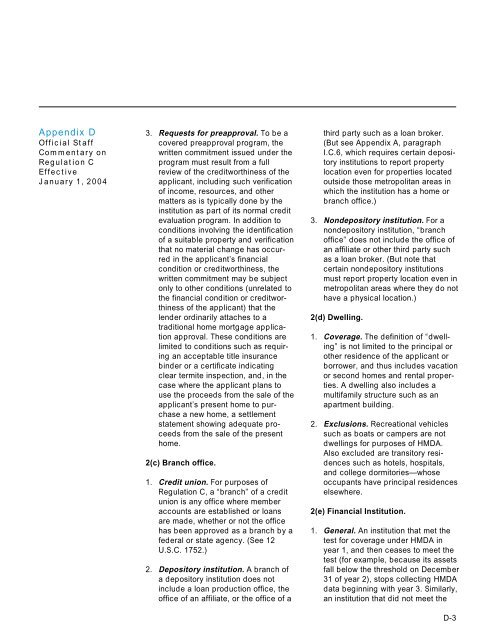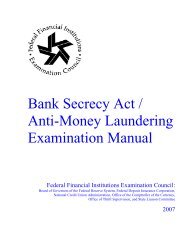A Guide to HMDA Reporting - ffiec
A Guide to HMDA Reporting - ffiec
A Guide to HMDA Reporting - ffiec
Create successful ePaper yourself
Turn your PDF publications into a flip-book with our unique Google optimized e-Paper software.
Appendix D 3. Requests for preapproval. To be a<br />
Official Staff covered preapproval program, the<br />
Commentary on written commitment issued under the<br />
Regulation C program must result from a full<br />
Effective review of the creditworthiness of the<br />
January 1, 2004 applicant, including such verification<br />
of income, resources, and other<br />
matters as is typically done by the<br />
institution as part of its normal credit<br />
evaluation program. In addition <strong>to</strong><br />
conditions involving the identification<br />
of a suitable property and verification<br />
that no material change has occurred<br />
in the applicant’s financial<br />
condition or creditworthiness, the<br />
written commitment may be subject<br />
only <strong>to</strong> other conditions (unrelated <strong>to</strong><br />
the financial condition or creditworthiness<br />
of the applicant) that the<br />
lender ordinarily attaches <strong>to</strong> a<br />
traditional home mortgage application<br />
approval. These conditions are<br />
limited <strong>to</strong> conditions such as requiring<br />
an acceptable title insurance<br />
binder or a certificate indicating<br />
clear termite inspection, and, in the<br />
case where the applicant plans <strong>to</strong><br />
use the proceeds from the sale of the<br />
applicant’s present home <strong>to</strong> purchase<br />
a new home, a settlement<br />
statement showing adequate proceeds<br />
from the sale of the present<br />
home.<br />
2(c) Branch office.<br />
1. Credit union. For purposes of<br />
Regulation C, a “branch” of a credit<br />
union is any office where member<br />
accounts are established or loans<br />
are made, whether or not the office<br />
has been approved as a branch by a<br />
federal or state agency. (See 12<br />
U.S.C. 1752.)<br />
2. Deposi<strong>to</strong>ry institution. A branch of<br />
a deposi<strong>to</strong>ry institution does not<br />
include a loan production office, the<br />
office of an affiliate, or the office of a<br />
third party such as a loan broker.<br />
(But see Appendix A, paragraph<br />
I.C.6, which requires certain deposi<strong>to</strong>ry<br />
institutions <strong>to</strong> report property<br />
location even for properties located<br />
outside those metropolitan areas in<br />
which the institution has a home or<br />
branch office.)<br />
3. Nondeposi<strong>to</strong>ry institution. For a<br />
nondeposi<strong>to</strong>ry institution, “branch<br />
office” does not include the office of<br />
an affiliate or other third party such<br />
as a loan broker. (But note that<br />
certain nondeposi<strong>to</strong>ry institutions<br />
must report property location even in<br />
metropolitan areas where they do not<br />
have a physical location.)<br />
2(d) Dwelling.<br />
1. Coverage. The definition of “dwelling”<br />
is not limited <strong>to</strong> the principal or<br />
other residence of the applicant or<br />
borrower, and thus includes vacation<br />
or second homes and rental properties.<br />
A dwelling also includes a<br />
multifamily structure such as an<br />
apartment building.<br />
2. Exclusions. Recreational vehicles<br />
such as boats or campers are not<br />
dwellings for purposes of <strong>HMDA</strong>.<br />
Also excluded are transi<strong>to</strong>ry residences<br />
such as hotels, hospitals,<br />
and college dormi<strong>to</strong>ries—whose<br />
occupants have principal residences<br />
elsewhere.<br />
2(e) Financial Institution.<br />
1. General. An institution that met the<br />
test for coverage under <strong>HMDA</strong> in<br />
year 1, and then ceases <strong>to</strong> meet the<br />
test (for example, because its assets<br />
fall below the threshold on December<br />
31 of year 2), s<strong>to</strong>ps collecting <strong>HMDA</strong><br />
data beginning with year 3. Similarly,<br />
an institution that did not meet the<br />
D-3
















